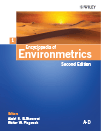Detection Limits†
Based in part on the article “Detection limits” by Hilko Van der Voet, which appeared in the Encyclopedia of Environmetrics.
Abstract
In analytical chemistry, the detection limit is the lowest level of an analyte that can reliably be detected by a well-defined operating procedure. It is often confused with the decision limit, which is a threshold of measurement used to determine whether or not the analyte is present in a particular study. We discuss the history and confusion relating to the definition in a univariate context. We consider the detection limit as a function of the sources of variation within an operating procedure. Estimation of the detection limit assuming constant variance in one-level designs and calibration designs is described, as well as a brief treatment of the assumption of non-constant variance. We outline modifications for multiple future detection decisions. Finally we consider approaches to multivariate detection, when decisions are based on more than one quantitative signal.



